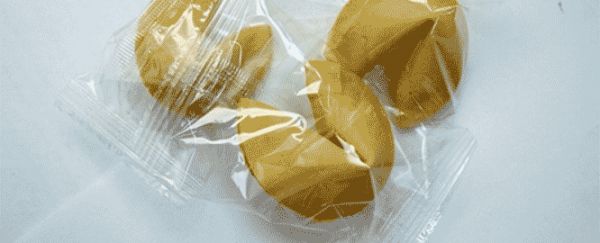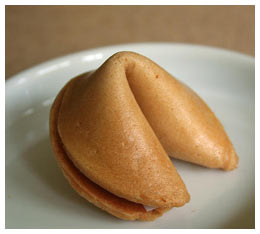An account by
Этот e-mail адрес защищен от спам-ботов, для его просмотра у Вас должен быть включен Javascript
© 2008 Erik S. Nagata
The fortune cookie was introduced into the USA by my relative and great, great grandfather, baron Makoto Hagiwara, at the Japanese Tea Garden, San Francisco. It was served in the garden as refreshment and a part of enjoying the garden experience. And was likely intorduced around the turn of the century. (1890s- early 1900s).
This confection was long known in Japan as a 'folkcraft' and was commonly enjoyed as a part of the New Year's festivities at Shinto shrines. A folded cookie was eaten and when it was broken open, it revealed a fortune inside. The flavoring of this original form was more savory, complementing the taste of green tea nicely. It was not then a sweet confection/cookie. Its Japanese name is tsuji ura sembei. It is a form of the great varieties of rice crackers so popular in Japan. This one was then a savory cookie back then.
'Folkcrafts' are not well documented in Japanese history, but there are rare examples of woodblock prints and other documentation which clearly shows the Japanese origin of the fortune cookie from olden times. Folkcrafts can be understood as something which everyone uses, enjoys, etc. but it is so common and not thought important enough to document (similar examples are pizza, pasta, etc. -- we all enjoy them , but no one seems to know exactly the history of the item).
My family introduced the confection at the Japanese Tea Garden, San Francisco and I believe my relative changed the flavoring (and variety of the sembei) to make it sweet. There are many sweet sembei rice cracker varieties in the Japanese culinary tradition and these are very palatable to Occidental taste preferences, whereas many of the savory types are not. The typical folded shape remained the same. It was baked and served in the Japanese Tea Garden while my family resided there (pre-World War II).
Our baker, Ben Kyo Do Company, began to produce them when demand became large. There were also other Japanese bakeries which produced them, but they are now gone. I have spoken with Gary Ono, one of that family's descendants and I have corresponded and became interested in the history of the cookie and we uncovered that history when I put him in touch with Yasuko Nakamachi, a then graduate student in Japan, doing her thesis on that same history. She introduced me to the history of the confection as it was known in Japan, and discovered by her research. I met Yasuko when she visited San Francisco and gave her a tour of the Tea Garden. We enjoyed our visit very much and she surprised me with the traditional flavored fortune cookie from Japan and other paper fortunes, so I got to sample the genuine article for myself. Later on, I put her in touch with Gary Ono, and the personnel of the Japanese National History Museum in Los Angeles.
Several of my late relatives and I have been interviewed by Japanese TV journalists trying to figure out the history of the fortune cookie and puzzling over how a Japanese invention, mysteriously became a 'Chinese' cookie as it went on its journey around the world. When one of my relatives was alive, he would, or would not, say a thing about the history depending on what particular mood he was in at the time. That was frustrating, so I always prefer to tell the plain and simple truth whenever possible, so that people will know as close as possible the actual true history as I know it.
Yasuko Nakamachi and Gary Ono communicated together and she sent her compilation of work at that time to Gary and myself so we cold translate and read the history from Japan for ourselves. I have given an interview to the Japanese National Historical Museum, Los Angeles, documenting what I knew up to that point in time and the project is in the works to be completed (as well as, the Japanese Tea Garden history with family album photographs). I find it so very intriguing that even though one family has a history, that same history is not alone and touches many others, just as interactions continue to do to this present day.
As my family was from the nobility, they only considered that invention and introduction of the fortune cookie as a pleasant refreshment to be enjoyed while strolling the garden and enjoying oneself. We did not think in business terms of patent or protections as is so common in the present day. That was all done au gratis, my family bearing the burden of costs.
The fortune cookie has a very simple recipe and began to be made by local Chinese who distributed it in their restaurants.
I have heard numerous arguments, stories, etc. about the history and validity of various other sources claiming to be the source of the fortune cookie and realized they were wrong and have attempted to clarify the matter time and again, here in print, once and for all, put down in crystal clarity the history of how the confusion began and explain the history to any with interest in finding out the history of such a widely popular item (some of the stories are inventions from Los Angeles area, which my family's introduction predates -- notes hidden in a bun/ other food articles -- these are NOT fortunes held within a sembei cookie/cracker).
The original way these fortune cookies were made was by hand. They are still done like that in Japan in the Kyoto region where they originated many, many years ago. Iron molds (something like a hand held waffle iron with handles) are circular in shape, depressed in the middles to hold the batter. There are examples extant with the initial MH in the mold, initials of my relative Makoto Hagiwara, and Gary Ono kindly gave me some from his family bakery's history (there are different motifs in his baking irons) These irons are called kata in Japanese and the original form is little changed from the extant examples. Of historical interest is that photographs of historical documentations from Yasuko Nakamachi detail these same style kata irons being used in woodblock prints from Japanese history.
 These irons were held over heat and batter poured into them. When done, the soft cookies were pliable when hot and that is the key. They need to be folded at this stage or they become brittle when cooled. An unique fold and paper fortune insertion and voila! a fortune cookie!
These irons were held over heat and batter poured into them. When done, the soft cookies were pliable when hot and that is the key. They need to be folded at this stage or they become brittle when cooled. An unique fold and paper fortune insertion and voila! a fortune cookie!
I have been told (as well my grand Aunt Haruko Hagiwara Matsuishi) that people come up and introduce themselves mentioning that they married after reading the fortune in a fortune cookie. Amazing! It was also she that told me of the history of how it was done in the Japanese Tea Garden while she lived in the garden with the rest of the family.
Back then, there were only felicitous fortunes. Nowadays there are all types and different flavors as well.
Chinese have marketed the confection so the world thinks this Japanese confection is Chinese, and Japanese are puzzled why a purely Japanese invention has circled the globe and become 'Chinese'. I hope to have explained things here and cleared the mystery.
To sum it up, the fortune cookie originated in Japan as a savory confection, was introduced to the world in San Francisco by my family and changed to become a sweetened cookie. Others took it and began to market it as their own, denying the true history with subjective bias, or omission, or just ignorance. It has become a universally known and loved pleasantry and thus with correct history is now presented in its accurate entirety.
Erik Sumiharu Hagiwara-Nagata
The History of the Fortune Cookie
Born in California, of Chinese American—or maybe Japanese American—origin
by Borgna Brunner
Like chop suey, fortune cookies are an American invention. They originated in California, but who the actual inventor was, and which city in California is the true home of the fortune cookie, has continued to be a matter of debate. Unequivocally not Chinese, the fortune cookie may in fact not even be Chinese American.
Chinese or Japanese, Angelino or San Franciscan?
One history of the fortune cookie claims that David Jung, a Chinese immigrant living in Los Angeles and founder of the Hong Kong Noodle Company, invented the cookie in 1918. Concerned about the poor he saw wandering near his shop, he created the cookie and passed them out free on the streets. Each cookie contained a strip of paper with an inspirational Bible scripture on it, written for Jung by a Presbyterian minister.
Another history claims that the fortune cookie was invented in San Francisco by a Japanese immigrant named Makoto Hagiwara. Hagiwara was a gardener who designed the famous Japanese Tea Garden in Golden Gate Park. An anti-Japanese mayor fired him from his job around the turn of the century, but later a new mayor reinstated him. Grateful to those who had stood by him during his period of hardship, Hagiwara created a cookie in 1914 that included a thank you note inside. He passed them out at the Japanese Tea Garden, and began serving them there regularly. In 1915, they were displayed at the Panama-Pacific Exhibition, San Francisco's world fair.
Judicial Activism
In 1983, San Francisco's pseudo-legal Court of Historical Review held a mock trial to determine the origins of the fortune cookie. (In the past, the Court had ruled on such pressing topics as the veracity of Mark Twain's quote, "The coldest winter I ever spent was a summer in San Francisco" and the origins of the Martini. *) To no one's surprise, the judge (a real-life federal judge from San Francisco) ruled in favor of San Francisco. Included among the evidence was a fortune cookie whose message read: "S.F. Judge who rules for L.A. Not Very Smart Cookie." Equally unsurprising, Los Angeles has denounced the ruling.
From Confucius to Smiley Faces
Fortune cookies became common in Chinese restaurants after World War II. Desserts were not traditionally part of Chinese cuisine, and the cookies thus offered Americans something familiar with an exotic flair.
Although there have been a few cases reported of individuals actually liking the texture and flavor of fortune cookies, most consider the fortune to be the essence of the cookie. Early fortunes featured Biblical sayings, or aphorisms from Confucius, Aesop, or Ben Franklin. Later, fortunes included recommended lottery numbers, smiley faces, jokes, and sage, if hackneyed, advice. Politicians have used them in campaigns, and fortunes have been customized for weddings and birthday parties. Today messages are variously cryptic, nonsensical, feel-good, hectoring, bland, or mystifying.
From Chopsticks to High Tech
Fortune cookies were originally made by hand using chopsticks. In 1964, Edward Louie of San Francisco's Lotus Fortune Cookie Company, automated the process by creating a machine that folds the dough and slips in the fortune. Today, the world's largest fortune cookie manufacturer, Wonton Food Inc. of Long Island CIty, Queens ships out 60 million cookies a month.
*After being served a Martini on the bench, the judge enthusiastically ruled that San Francisco was the home of the famous cocktail. The city of Martinez, California, appealed the ruling.
- More from Asian Pacific American Heritage Month
History of Fortune Cookies
Anyone who has been to a Chinese restaurant has had, or at least seen, fortune cookies. These almond or vanilla flavored treats not only taste great, but they have a surprise inside – a small strip of paper with a prediction or saying printed on it. The fortune cookie is a cookie with a piece of paper inside with words of supposed wisdom and/or prophecy.
The idea of fortune cookies was introduced by Makoto Hagiwara at the Japanese Tea Garden in Golden Gate Park, San Francisco, as a refreshment to be taken while strolling the tea garden. The Hagiwara family was not business oriented, and there was never a patent taken out on the fortune cookie in any form (name, rights, cookie itself, or otherwise). This confection is said to be based off of a Japanese food known as tsujiura senbei, which is associated with New Year festivities at Shinto Shrines.
The tsujiura senbei, several generations old, is not sweet like the fortune cookies that were designed to fit American tastes. The novel idea of receiving a fortune in a light senbei cookie is not widely known in Japan. The tsujiura senbei contains a tsujiura (a writing that tells one's fortunes) inside a senbei (Japanese crackers). This senbei is traditionally found in Kyoto.
The origins of the Fortune Cookie as we know it today were laid down by the Chinese 49'ers who worked on the building of the great American railways through the Sierra Nevada into California.
Work was very hard and pleasures were few in isolated camps, those hard workers had only biscuits with happy messages inside, to exchange at the Moon festival instead of traditional cakes with happy messages, and thus the Fortune Cookie was born. This became something of a cottage industry and as the Chinese settled in San Francisco after the railway and the Gold boom the custom continued. Today it is almost impossible to have a Chinese meal in America and Canada without finishing with a Fortune Cookie.
After WWII, a number of Americanized Chinese restaurants copied the idea. Fortune cookies became very popular, served as a dessert after every meal at many restaurants. In addition to a fortune, fortune cookies may also contain lucky numbers (used by some as lottery numbers) and a Chinese phrase with translation.
Although they are served almost exclusively in Chinese restaurants abroad, fortune cookies are almost unknown in China. Places that serve them call them "Genuine American Fortune Cookies."








 Область применения
Область применения

